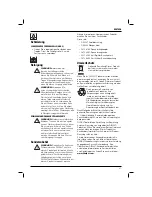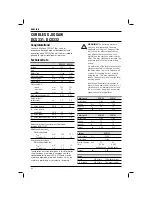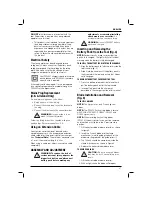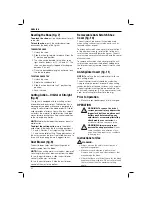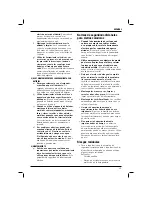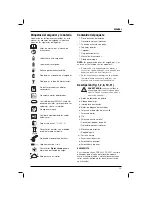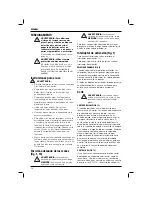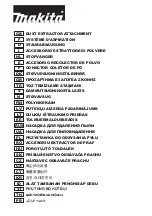
ENGLISH
43
• Use sharp saw blades only. Damaged or bent
saw blades must be removed immediately.
• Never run your tool without a saw blade.
• For optimal results, move the tool smoothly
and constantly over the workpiece. Do not
exert lateral pressure on the saw blade. Keep
the shoe flat on the workpiece. When sawing
curves, circles or other round shapes, push the
tool gently forward.
• Wait until the tool has come to a standstill
before removing the saw blade from the
workpiece. After sawing the blade may be very
hot. Do not touch.
Proper Hand Position (fi g. 1, 14)
WARNING:
To reduce the risk of
serious personal injury,
ALWAYS
use
proper hand position as shown.
WARNING:
To reduce the risk of
serious personal injury,
ALWAYS
hold
securely in anticipation of a sudden
reaction.
Proper hand position requires one hand on the top
handle (q), with the other hand on the main handle
(p).
Trigger Switch (fi g. 1)
To start the jig saw, squeeze the trigger switch (c).
To slow and stop the jig saw, release the trigger
switch.
VARIABLE SPEED (FIG. 5)
As the trigger switch is pressed in, the strokes-
per-minute continue to increase, but not to exceed
the maximum speed of the tool. As the trigger is
released, the blade strokes-per-minute reduce.
The trigger lock button (d) should be depressed
whenever the tool is not in use to eliminate the
chance of accidental starting.
Cutting
WARNING:
The jig saw should not be
operated with the shoe removed or
serious personal injury may result.
POCKET CUTTING (FIG. 12)
A pocket cut is an easy method of making an inside
cut. The saw can be inserted directly into a panel
or board without first drilling a lead or pilot hole. In
pocket cutting, measure the surface to be cut and
mark clearly with a pencil. Next tip the saw forward
until the front end of the shoe sits firmly on the work
surface and the blade clears the work through its
full stroke. Switch the tool on and allow it to attain
maximum speed. Grip the saw firmly and lower the
back edge of tool slowly until the blade reaches
its complete depth. Hold the shoe flat against the
wood and begin cutting. Do not remove blade from
cut while it is still moving. Blade must come to a
complete stop.
FLUSH CUTTING (FIG. 13)
A flush cut is necessary when finishing off cuts up
to a wall or an obstacle, such as back-splash. One
of the easiest ways to accomplish the flush cut is to
use a flush cutting blade (DT2074). The flush cutting
blade provides the reach necessary to cut right up
to the front edge of the jig saw shoe. Remove the
anti-splinter insert and return the shoe to the 0°
positive stop position before installing and using the
flush cutting blade. For the best cut quality the flush
cutting blade should be used in the 0 or 1 orbital
position. The flush cutting blade should not be used
to start the cut because the flush cutting blade
prevents the shoe from being supported by the
work surface. Use wood cutting practices explained
below.
WOOD CUTTING
Support the workpiece adequately at all times. Use
the higher speed setting for cutting wood. Do not
attempt to turn the tool on when blade is against
material to be cut. This could stall the motor. Place
the front of shoe on the material to be cut and
hold the jig saw shoe firmly against the wood while
cutting. Don’t force the tool; let the blade cut at its
own speed. When the cut is complete, turn the jig
saw off. Let blade come to a complete stop and
then lay the saw aside before loosening the work.
METAL CUTTING
In cutting thin gauge sheet metals, it is best to clamp
wood to the bottom of sheet metal; this will insure
a clean cut without the risk of vibration or tearing
of metal. Always remember to use a finer blade
for ferrous metals (for those that have a high iron
content); and use a coarser blade for non-ferrous
metals (those that do not have an iron content).
Use a high speed setting for cutting soft metals
(aluminum, copper, brass, mild steel, galvanized.
pipe, conduit sheet metal, etc.). Use lower speed
to cut plastics, tile, laminate, hard metals, and cast
iron.
MAINTENANCE
Your D
E
WALT power tool has been designed to
operate over a long period of time with a minimum
of maintenance. Continuous satisfactory operation
depends upon proper tool care and regular cleaning.
Содержание XR DCS331
Страница 1: ...www eu DCS331 DCS332 ...
Страница 3: ...1 a b c d e f g h Figure 1 Figure 2 i j q p ...
Страница 4: ...2 Figure 3 Figure 4 b a b Figure 5 d Figure 6 e k l d ...
Страница 5: ...3 f g h i Figure 7 Figure 8 Figure 9 ...
Страница 6: ...4 g j m n g j Figure 10 Figure 11 Figure 12 Figure 13 ...
Страница 7: ...5 Figure 14 ...



